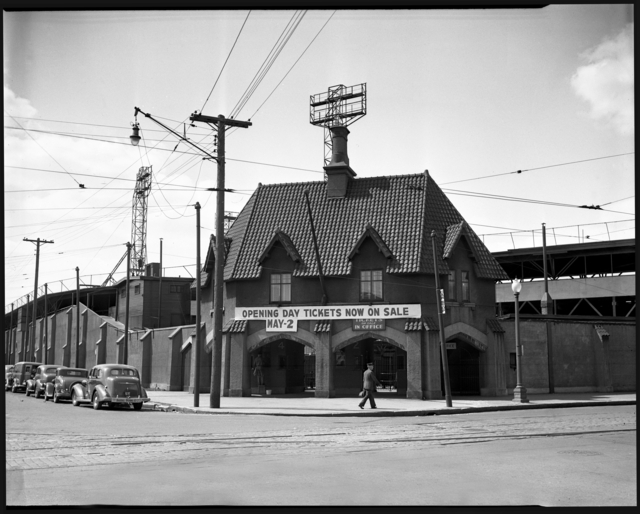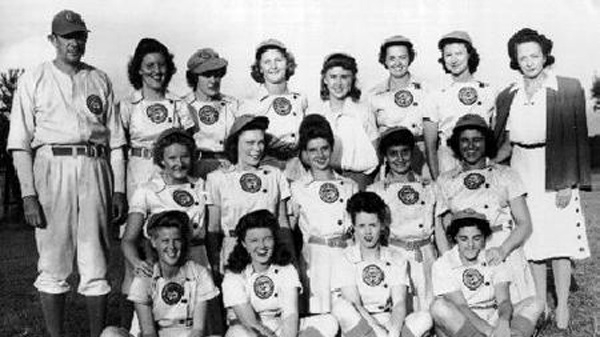Dirt on Their Skirts: The Minneapolis Millerettes
“It was a time when women took over men’s positions as they went off to war, not only in the field of manufacturing, but on the field of dreams.”—Annabelle Lee
In 1944, a group of talented athletes took the field at Nicollet Park in Minneapolis to wild cheering from the stands. Spectators stood as the team took their places on the baseball diamond. But instead of knee-length baseball pants, the team wore short skirts with silk shorts underneath and maroon-colored knee socks. Perfectly coiffed hair billowed from under their caps.
These weren’t the typical athletes that the crowds came to Nicollet Park to see, but the year was 1944 and most of the country’s men were off fighting in World War II. Fans of America’s favorite pastime didn’t suffer because of the war—a new team was composed of national female talent. They became known as the Minneapolis Millerettes.

The Millerettes opened their season on May 27, 1944, against the Rockford Peaches. Unfortunately, the Millerettes lost their first game despite taking an early lead. Even so, several of the players were recognized for their impressive throwing arm or ground-covering catches in the field. Throughout the first few weeks of the season, the Millerettes played well and won several games. The crowds steadily grew to hundreds of fans crowding into the stands at each home game.
A slump followed their initial success that soon sunk them into last place in the league by the end of the first half of the season with a win-loss record of 23-36. The second half of the season was met with dwindling crowds and frequent losses.
Other teams in the All-American Professional Girls Baseball League (AAGPBL) began to complain about the long bus trip to Minneapolis to play for such small crowds. The Minneapolis Millerettes were causing the league to lose money and credibility. By late-July the Millerettes home games were switched to other cities and the team was forced to play all of their remaining games on the road.
At the time, team manager Claude “Bubber” Jonnard blamed the lack of support in Minneapolis on the hostile press in the city. Minneapolis was one of the largest cities with a women’s baseball team, so the coverage of the games was hindered not only by other sports teams in town, but also competed with headlines about the war and patriotic rhetoric. The Minneapolis Tribune was initially enthusiastic about reporting on the team and placed their results and photos from the games on the front page. But by the second half of the season, the team was relegated to the Sports page—and that was only if they won. Bubber believed this was the cause of the dwindling attendance and lack of support for the ladies.

The Millerettes ended their season 26 games out of first place with a win-loss record of 45-72.
Although some teams in the All-American Professional Girls Baseball League played for a dozen years, the Millerettes only lasted one season in Minneapolis. Lack of support from sports fans in the Twin Cities forced the team to move to Fort Wayne, Indiana for the 1945 season. Their name was changed to the Fort Wayne Daisies. In 1945, the Daisies had a 62-47 win-loss record and finished the season just four games behind the first place Rockford Peaches. The Daisies played in Fort Wayne until 1954.
Millerettes team highlights in 1944:
- Former bank clerk Annabelle Lee pitched the first perfect game in AAGPBL history on July 29, 1944.
- Pitcher Dorothy Wiltse ended the season with a 20-16 record and a 1.88 ERA in 38 appearances.
- Outfielder Helen Callaghan finished second in the league in batting average (.287) and third in runs (81), hits (114), home runs (3), and total bases (136).
- Center fielder Faye Dancer became the girl to hit two home runs in a single game and posted two grand slams for the team.
- Outfielder Lillian Jackson stole 24 bases in just 58 games.
Team roster for the Minneapolis Millerettes in 1944:
Kay Blumetta
Edna Frank
Elizabeth Mahon
Lorraine Borg
Audrey Haine
Anna Meyer
Helen Callaghan
Lillian Jackson
Lavonne Paire
Margaret Callaghan
Marguerite Jones
Irene Ruhnke
Faye Dancer
Vivian Kellogg
Lorraine Torrison
Julie Dusanko
Audrey Kissel
Betty Trezza
Loretta Dwojak
Annabelle Lee
Margaret Wigiser
Elizabeth Farrow
Ruth Lessing
Dorothy Wiltse
